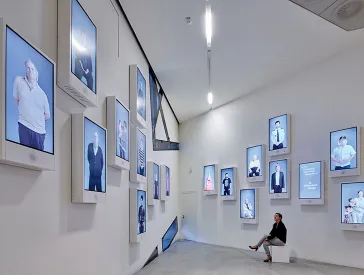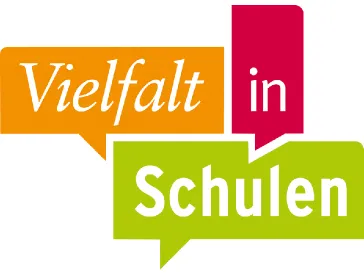A Three-Perspective Approach
Bringing Together an Interculturally Aware School, a Diversity-Focused Museum, and Anti-Discrimination Education
Report on a Panel Discussion
Anyone wishing to consider and compare the educational work done at schools and museums in societies shaped by migration must address a number of fundamental questions: How is diversity-focused, anti-discrimination education defined? What does intercultural awareness mean for schools? What does it mean for museums? In brief presentations, three experts from the participating fields presented perspectives and discussed the various interfaces, possibilities, and limitations of collaboration. Dr. Rosa Fava moderated the discussion among the following participants:
- Zahide Doğaç, teacher and intercultural coordinator, Hamburg
- Ibrahim Gülnar,Ostkreuz mobile consulting team, Social Pedagogical Institute, Berlin
- Leontine Meijer-van Mensch, Museum of European Cultures – State Museums of Berlin

Where
Old Building, level 2, Great Hall
Lindenstraße 9–14, 10969 Berlin
Zahide Doğaç: What Is an Interculturally Aware School?
The composition of German society is changing. In urban centers such as Hamburg and Berlin, classrooms are becoming ever more diverse. According to current statistics, every second elementary school student in Hamburg has foreign heritage. As a result, there is a need for not only new staff, but also new structures geared toward this cultural and social diversity. For schools, this means two things: responsible action must be adapted to the changed migration processes in civil society, and the institutions themselves must be adapted to social realities.
But how should this be done? During their studies and in their professional lives, teachers and other education professionals must be trained and prepared for these processes of change. In my opinion, it is essential for teaching staff to develop an awareness of intercultural issues. In order to provide a foundation for sustainable, resource-oriented education policies, educational facilities and the institutions of civil society must embrace an anti-bias approach as a fundamental concept and firmly incorporate it into school life.
Change management requires time and proper planning. The first step is to become aware of the structures and contexts of educational institutions. The seeds for intercultural awareness can be sown only if this awareness is made part of school development processes.
Experience has shown that autonomy in the area of school development leads to schools that differ markedly from one another. As a result, different strategies are required for long-term projects. An analysis of each individual school is important to reach targeted agreements. For school development processes, it is crucial to use (and, if necessary, to build on) each school’s resources.
Who has carried out intercultural projects of this type in the past? Who is interested in them? Are there colleagues who have completed a special course of study or an advanced training program? The process of working with fixed coordinators and contracting with the actors of civil society (MSOs, NGOs, museums, etc.) can create a network of resources and expertise and ensure an effective division of labor and transparent structures. Finally, for school development processes, it is important for projects to be evaluated and validated and for their results to be publicized (PR work).
What does an interculturally aware school look like? In an interview on 26 April 2013, Yasemin Karakaşoğlu answered this question as follows:
“The diversity of society should be reflected on all levels of the school – in the curriculum, the organization of lessons, teacher training, and staff composition. Regardless of their biographical background, resources, and ideas about the future, everyone should find something at school that they can identify with.”
Ibrahim Gülnar: Diversity at Schools
Pluralistic, heterogeneous societies are made up of people with very different characteristics and identities. This reality is particularly evident at schools, which bring together people of different ages, social and educational backgrounds, ethnic and religious affiliations, physical abilities, and sexual orientations.
But what criteria must schools fulfill in order to manage diversity successfully and prevent discrimination? With the model projects Diversity Shapes Schools and NÜRTIKULTI – Diversity Shapes Elementary Schools, the Ostkreuz mobile consulting team from the Social Pedagogical Institute Berlin has gained extensive experience in recent years on how to implement sustainable and inclusive diversity education both in everyday school life and in youth and educational facilities at large.
Educational institutions face the question of how to create an inclusive learning environment for all students that makes it possible to manage diversity in school life while ensuring equal opportunity for all. The focus was on the structural level (organizational development), the individual level (teachers’ attitudes and conceptions), and the level of pedagogical culture (teaching practice, self-definition, guiding principles). The goal was to foster appreciation for diversity and difference, ensure equal opportunity for all, and raise awareness of exclusion mechanisms.
Leontine Meijer-van Mensch: Polyphony in Museums
Since the 1970s, the calls for museums to play an active role in society have been growing louder. Since the turn of the twenty-first century, the idea of social responsibility in the museum world has likewise been gaining ground. As a result, the three aspects of social integration – access, representation, and participation – are increasingly seen as instrumental to long-term work in museums.
The basic premise of contemporary museology is that museum collections should be regarded as a means to achieve specific goals. This premise is linked to the view that the special significance of museums as cultural institutions lies in their use as a means, not as an end in themselves. The Tyne & Wear Archives & Museums (Newcastle, UK) provides a good example of a modern mission statement that emphasizes a broader purpose: “Our mission is to help people determine their place in the world and define their identities, so enhancing their self-respect and their respect for others.”
It is important to make the diversity of the population visible in museums – particularly in urban contexts, which are markedly shaped by this heterogeneity. This can be accomplished, for example, by empowering as many people as possible to contribute to museums’ design and by giving them a say in what is shown there. In my opinion, museums need to change from being “about something” to being “for someone.”
Contact
Dr. Diana Dressel
Head of Education Department
T +49 (0)30 259 93 515
d.dressel@jmberlin.de
Conference Documentation: Schools and Museums Conference Working Groups (19)


